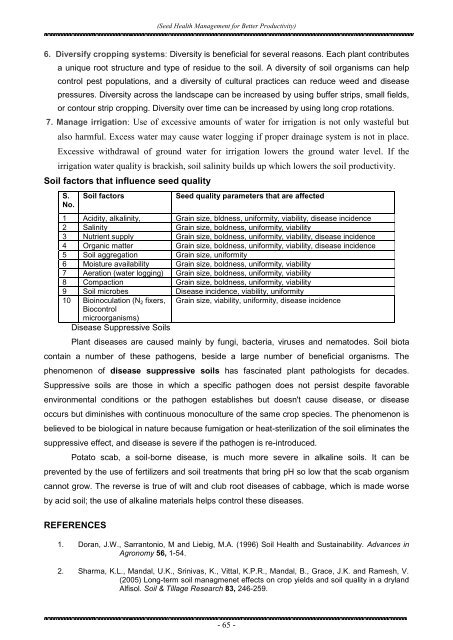Seed Health Management for Better Productivity - Govind Ballabh ...
Seed Health Management for Better Productivity - Govind Ballabh ...
Seed Health Management for Better Productivity - Govind Ballabh ...
Create successful ePaper yourself
Turn your PDF publications into a flip-book with our unique Google optimized e-Paper software.
(<strong>Seed</strong> <strong>Health</strong> <strong>Management</strong> <strong>for</strong> <strong>Better</strong> <strong>Productivity</strong>)6. Diversify cropping systems: Diversity is beneficial <strong>for</strong> several reasons. Each plant contributesa unique root structure and type of residue to the soil. A diversity of soil organisms can helpcontrol pest populations, and a diversity of cultural practices can reduce weed and diseasepressures. Diversity across the landscape can be increased by using buffer strips, small fields,or contour strip cropping. Diversity over time can be increased by using long crop rotations.7. Manage irrigation: Use of excessive amounts of water <strong>for</strong> irrigation is not only wasteful butalso harmful. Excess water may cause water logging if proper drainage system is not in place.Excessive withdrawal of ground water <strong>for</strong> irrigation lowers the ground water level. If theirrigation water quality is brackish, soil salinity builds up which lowers the soil productivity.Soil factors that influence seed qualityS.No.Soil factors<strong>Seed</strong> quality parameters that are affected1 Acidity, alkalinity, Grain size, bldness, uni<strong>for</strong>mity, viability, disease incidence2 Salinity Grain size, boldness, uni<strong>for</strong>mity, viability3 Nutrient supply Grain size, boldness, uni<strong>for</strong>mity, viability, disease incidence4 Organic matter Grain size, boldness, uni<strong>for</strong>mity, viability, disease incidence5 Soil aggregation Grain size, uni<strong>for</strong>mity6 Moisture availability Grain size, boldness, uni<strong>for</strong>mity, viability7 Aeration (water logging) Grain size, boldness, uni<strong>for</strong>mity, viability8 Compaction Grain size, boldness, uni<strong>for</strong>mity, viability9 Soil microbes Disease incidence, viability, uni<strong>for</strong>mity10 Bioinoculation (N 2 fixers, Grain size, viability, uni<strong>for</strong>mity, disease incidenceBiocontrolmicroorganisms)Disease Suppressive SoilsPlant diseases are caused mainly by fungi, bacteria, viruses and nematodes. Soil biotacontain a number of these pathogens, beside a large number of beneficial organisms. Thephenomenon of disease suppressive soils has fascinated plant pathologists <strong>for</strong> decades.Suppressive soils are those in which a specific pathogen does not persist despite favorableenvironmental conditions or the pathogen establishes but doesn't cause disease, or diseaseoccurs but diminishes with continuous monoculture of the same crop species. The phenomenon isbelieved to be biological in nature because fumigation or heat-sterilization of the soil eliminates thesuppressive effect, and disease is severe if the pathogen is re-introduced.Potato scab, a soil-borne disease, is much more severe in alkaline soils. It can beprevented by the use of fertilizers and soil treatments that bring pH so low that the scab organismcannot grow. The reverse is true of wilt and club root diseases of cabbage, which is made worseby acid soil; the use of alkaline materials helps control these diseases.REFERENCES1. Doran, J.W., Sarrantonio, M and Liebig, M.A. (1996) Soil <strong>Health</strong> and Sustainability. Advances inAgronomy 56, 1-54.2. Sharma, K.L., Mandal, U.K., Srinivas, K., Vittal, K.P.R., Mandal, B., Grace, J.K. and Ramesh, V.(2005) Long-term soil managmenet effects on crop yields and soil quality in a drylandAlfisol. Soil & Tillage Research 83, 246-259.- 65 -
















